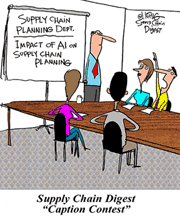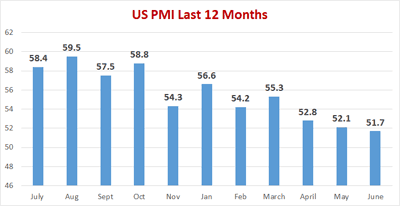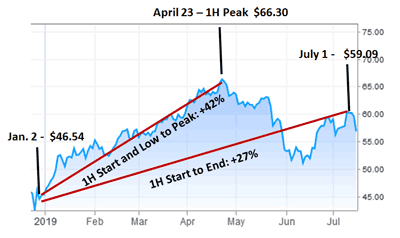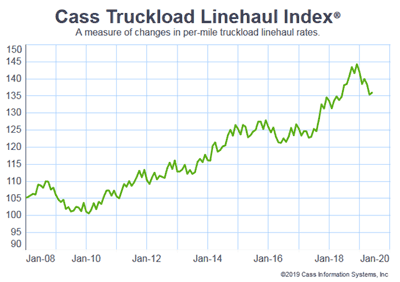 |
July 19, 2019 - Supply Chain Flagship Newsletter |
 |
|
||||||||||
 |
|
|||||||||||||||||||||||||||||||||||||||||||||||||||||||||||||||||||||||||||||||||||||||||||||||||||||||||||||||||||||||||||||||||||||||||||||
|
||||||||||||||||||||||||||||||||||||||||||||||||||||||||||||||||||||||||||||||||||||||||||||||||||||||||||||||||||||||||||||||||||||||||||||||
Another view of US manufacturing strength is the index on output for US factories from the Federal Reserve.
US manufacturing output accelerated in June, climbing for the second straight month, thanks in large part to increased production of motor vehicles and parts. The Federal Reserve said this week that manufacturing production rose 0.4% last month, above the 0.2% expected by analysts in a Reuters poll. The June numbers were stronger than the 0.2% growth seen in May, which had been the first growth of 2019 after several months of manufacturing declines or flatness. What's more, that also means current output remains well below the peak year of 2007, when the index reached an historic high of 110.0 in December. Oil prices were mostly up in the quarter, though dropping in the last couple of months. The price for WTI started $46.54 per barrel, which turned out to be the lowest level of the 1H. The price went up steadily until reaching a 1H peak of $66.30 in late April, a gain of 42% from the start. But it was mostly downhill from there, with a price at the end of June of $59.09, a gain of 27% since the beginning of the year. |
||||||||||||||||||||||||||||||||||||||||||||||||||||||||||||||||||||||||||||||||||||||||||||||||||||||||||||||||||||||||||||||||||||||||||||||
Despite those rather significant gyrations, US diesel prices were remarkably stable, starting the year at $3.04, rising a bit to a 1H high of just $3.17 the week of May 6, and then falling back to the same $3.04 level that started the year at the end of June. Commodity and input prices were falling for most of the 1H, after a very long period of increases. The ISM Prices index indicated rising input prices for the 34th straight month in December, but dropped into negative territory in January. The index was below 50 - indicating falling prices - again in February, before popping a bit above 50 for the next three months. The June level dropped again to just just 47.9, clearly signaling demand is weakening and causing falling procurement costs. Freight volumes were mixed, with ATA freight tonnage index down 6.1% in May (no June number yet). Compared with May 2018, the index increased 0.9%, the smallest year-over-year gain since April 2017. "Tonnage appears to be leveling off," the ATA says - another sign of a slowing economy.
After a torrid 2018, the Cass truckload Linehaul Index, which tracks truckload rates,slowed considerably here in 2019.
As can be seen in the chart below, rates were trending down since the start of the year, and in June were up just 0.9% year-over-year. "The trajectory on a nominal basis strongly suggests that the TL index will go negative next month and stay negative (compared to 2018) through the end of the year," Cass notes, is goods news for shippers. |
||||||||||||||||||||||||||||||||||||||||||||||||||||||||||||||||||||||||||||||||||||||||||||||||||||||||||||||||||||||||||||||||||||||||||||||
It was a tough first half for US railroads. Total US rail traffic for 1H 2019 was down 3.1%, while the once fast growing intermodal component was down 3.2%. In terms of ocean container carriers, the China Containerized Freight Index jumped to a two-year high of 890 at the end of January, coinciding with the tail-end of the great US container import boom, precipitated by the great pull-forward of 2018. But keep in mind that still means rates were more than 10% below those seen in 1998! The index then promptly fell below 800 late April before ending June at about 815. No wonder carriers can't make any money. The World Trade Organization expects trade to rise by a mere 2.6% in 2019 - the same as projected global GDP growth (which is lower than the IMF forecast cited above). Not long ago, it was common for global trade to be double the rate of GDP growth.
But it is making money - net income in the quarter was a robust $3.6 billion, a record.
What is your reaction of 1H supply chain 2019 in numbers and charts? What would you add? Let us know your thought at the Feedback button below. |
||||||||||||||||||||||||||||||||||||||||||||||||||||||||||||||||||||||||||||||||||||||||||||||||||||||||||||||||||||||||||||||||||||||||||||||
|
|
|
YOUR FEEDBACK
Some of the short feedbacks on our recent piece on The Top Supply Chain Innovations of All-Time
Feedback on The Top Supply Chain Innovations of All-Time:
![]()
Always enjoy reading your work and it was a great pleasure to see our Continuous Replenishment Program (CRP) ranked #2 of your Top Supply Chain Innovations. CRP certainly served to transform how the grocery industry operates, initially leading to the Efficient Consumer Response initiative, Collaborative Planning, Forecasting and Replenishment (CPFR) and in turn strategic retailer/supplier partnerships.
Ralph Drayer
Supply Chain Insights LLC

![]()
Very informative.
Just for the record and to be accurate, when you update your list do not forget to accurately represent the background history that led to P&G's CRP initiative with Walmart & Kmart.
Had RP&G followed up on mu recommendation back in 1988, P&G and Walmart would have been the very first users of what we call "Flowcasting" 20 years earlier than Kraft and and Walmart did.
Andre Martin
Co-Inventor
Distribution Requirements Planning
and Flowcasting

a
![]()
Fantastic, well researched list of innovations. Thanks for the work.
Steve Collins
Chicagoland

![]()
Wow, Dan thanks for the Kudos on behalf of all of IBM on the innovation article. Hope we can live up to our past in the future of this area.
Erik Bergeman
IBM Retail Solution Executive
SUPPLY CHAIN TRIVIA ANSWER
Q: What did Procter & Gamble do with Schnuck's Markets in St. Louis in about 1987?
A: Pioneered the use of Continuous Replenishment.
| © SupplyChainDigest™ 2003-2019. All Rights Reserved. SupplyChainDigest PO Box 714 Springboro, Ohio 45066 |
POWERED BY: XDIMENSION
|













